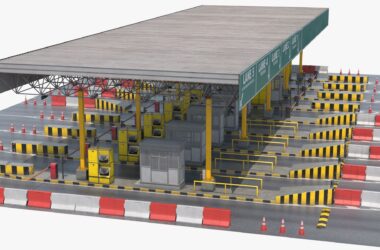The way law enforcement agencies track cars around the world has been completely transformed by ALPR technology. Its quick and precise recognition skills make it a valuable tool for tracking down suspects, recovering stolen cars, and conducting crime investigations.
Furthermore, the ability of law enforcement to monitor vehicles has been greatly enhanced by the integration of Dashcams with ALPR systems. This potent combination makes it possible to record license plate Numbers in real-time, giving authorities the ability to promptly recognize suspicious vehicles and collect the required evidence, thus improving the efficiency of law enforcement operations.
However, these systems encounter various challenges, especially when bad weather and deliberately concealed license plates exist. Therefore, this blog will discuss ALPR technology’s workings, use cases, and optimization techniques for law enforcement.
How ALPR Technology Works
The procedure of reading and identifying vehicle license plates is automated by ALPR technology. It uses a combination of cameras, software, and databases. The following is a summary of how ALPR technology works.
- Capturing License Plate Data: ALPR systems use cameras to take pictures of cars and then use optical character recognition (OCR) technology to retrieve the license plate number.
- Optical Character Recognition (OCR) Process: Every character on the license plate image is recognized and defined by the OCR function, which then transforms into computer characters coded for comparison.
- Database Matching and Alerts: The system compares the extracted license plate data to a recognized plate database to determine whether a match exists. The system can initiate predetermined responses or inform the appropriate authorities if a match is found.
Role of Alpr Technology in Law Enforcement
ALPR technology is valuable equipment that transforms law enforcement and offers significant security benefits. It assists in finding and recovering stolen cars by quickly scanning automobiles as they pass and comparing their license plates to stolen vehicle databases.
It also improves traffic safety and compliance by identifying vehicles with expired registrations or no insurance. Optimizing ALPR technology’s performance is essential to ensuring its effective use for law enforcement purposes. Here are some ways to do so.
- Proper Camera Placement: Cameras must be precisely positioned and angled to get accurate images of license plates. They should be placed at the ideal height with the fewest possible obstacles between them and the road.
- Regular Maintenance: Regular maintenance is necessary for ALPR systems to ensure optimal functioning, just like any other technology. This includes checking for defects, cleaning cameras and lenses, and upgrading software.
- Integrating with Other Technologies: Law enforcement gains a potent tool when Dashcams and ALPR devices are integrated. It provides alerts in real-time, enhances the video’s admissibility as evidence, and raises the general effectiveness and security of police operations.
Integration of Dashcams with ALPR Systems
ALPR Technology in advancing law enforcement, involves the integration of dashcams, which are cameras mounted in police vehicles, with ALPR systems. This integration allows for better surveillance and data collection capabilities by capturing real-time footage of license plates.
Officers obtain extra evidence, such as the driver’s face or other objects that could be important to an investigation, by using dashcams, which record the vehicle’s visual environment. Dashcam Footage can also be used to support ALPR data, giving the testimony in court more weight.
ALPR systems with dashcams also allow officers to receive real-time alerts on their mobile devices, providing them with crucial information even while they are on the move. This feature is essential and particularly helpful in high-speed pursuits, where officers require immediate updates on a vehicle’s location.
Advantages of ALPR Systems Integrated with Dashcams
Modern law enforcement benefits greatly from using dashcams equipped with ALPR technology. The strengths, efficiency, effectiveness, and accountability of these potent technologies are enhanced by one another. Guaranteeing that law enforcement gets alerts and updates instantly throughout operations greatly improves situational awareness and reaction. Below is a discussion of a few of them.
- Real-Time Tracking: Integrating ALPR with mobile dashcams on patrol cars enables real-time location tracking of flagged vehicles (stolen cars, wanted individuals). This allows officers to pinpoint the vehicle’s direction and potentially intercept it.
- Expanded Coverage: Patrolling police may cover a far greater area when their dashcams are ALPR-integrated, increasing the likelihood of encountering unusual vehicles. This translates to a more efficient use of law enforcement resources.
- Real-time Notifications: It ensures that law enforcement gets alerts and updates right away throughout operations, greatly improving situational awareness and reaction.
Confronting Weather and Environmental Challenges In Law Enforcement
Though unfavorable weather conditions like rain, snow, and fog can reduce the effectiveness of ALPR systems, they are still essential tools for law enforcement. It may be challenging for the system to correctly interpret the characters in license plate images due to these conditions. To improve ALPR performance during inclement weather, consider these solutions.
Challenge #1 Physical Obstructions
Any physical object that blocks the camera’s view of the license plate, like trees, poles, parked cars, and other objects, might make it difficult or impossible to see.
Solution
The license plate can be photographed from many viewpoints, even if it is partially concealed from one aspect, thanks to the installation of multiple cameras.
Challenge #2 Intentional Concealment
Criminals or individuals seeking to avoid surveillance may deliberately obscure their license plates with covers, mud, or other materials.
Solution
Anti-surveillance measures using infrared or night-vision cameras to capture license plates even in low-light conditions, where concealment attempts are more common.
Challenge #3 Partial Occlusions
Even minor blockage and dust, such as a tilted license plate or a dirty lens, can make it difficult for the ALPR system to read the characters accurately.
Solution
Image pre-processing techniques like image sharpening and noise reduction to improve the quality of the captured image.
Top Use Cases of ALPR Technology
Apart from its primary use in recovering stolen vehicles and enforcing traffic laws, Use cases of ALPR technology in law enforcement extend to various areas. Some of them include:
- Aiding in Amber Alerts and Missing Persons Cases: The agonizing search for missing children is a race against time. ALPR systems can be linked to Amber Alert databases, allowing real-time scanning of license plates to identify vehicles matching the disappeared child’s car. This significantly improves the chances of a swift recovery by providing crucial leads to investigators.
- Generating Investigative Leads and Crime Scene Analysis: Traditional investigative methods can be slow and resource-intensive. When combined with video footage from dashcams or security cameras, ALPR offers valuable investigative tools. By searching for license plates captured near crime scenes, investigators can identify vehicles of interest, track their movements, and potentially uncover crucial connections to the case.
- Enhancing Counterterrorism and Border Security: Constant attention to detail is necessary to ensure border security and prevent terrorist activity. When placed at border crossings or close to critical areas, ALPR systems can scan license plates against watchlists of known or suspected terrorists and criminals. This enhances national security operations by enabling the real-time identification of possible threats.
Future Trends and Innovations in ALPR for Law Enforcement
ALPR’s future role in law enforcement is characterized by ongoing research to advance accuracy and adaptability. Innovations in the pipeline include improved algorithms, integration with emerging technologies, and collaborations with smart city initiatives.
These advancements are expected to further elevate ALPR systems’ capabilities, ensuring their relevance and effectiveness in an ever-evolving technological landscape. Below are some of them.
- Advanced algorithms: Deep learning and edge computing will refine plate recognition, even in extreme conditions or obfuscation attempts. These advancements will improve identification accuracy and expand ALPR’s applications.
- Sensor fusion: Integrating LiDAR, radar, and other sensors will provide rich contextual data, improving object identification and tracking. This will allow for more comprehensive surveillance and situational awareness for law enforcement.
- Predictive analytics: ALPR data combined with AI will anticipate traffic patterns, optimize resource allocation, and prevent congestion. It will also assist in detecting suspicious vehicle behavior patterns for proactive law enforcement.
- Smart city integration: ALPR systems will seamlessly connect with intelligent transportation systems, enabling real-time traffic management and emergency response. This will also facilitate interoperability with other city services, ultimately making cities safer and more efficient.
- Cybersecurity enhancements: Robust security measures will be crucial to address data privacy concerns and prevent unauthorized access. This will ensure the integrity and reliability of ALPR systems, safeguard sensitive information, and maintain public trust.
- Personalization and customization: Users will have more control over data use and access, aligning with evolving privacy regulations. Customizable features like license plate whitelisting and blacklisting will allow for personalized ALPR use tailored to specific law enforcement needs.
Conclusion
ALPR technology confronts the dual challenges of weather and occlusion through forward-thinking solutions, including advanced sensors, powerful AI algorithms, and real-time adaptability. By successfully navigating these challenges, it provides a robust tool capable of high-speed, accurate data processing even in the most adverse conditions.
As technology progresses, law enforcement agencies must adapt and use dashcams with ALPR to locate vehicles and continually enhance their capabilities in serving the communities they safeguard. This proactive approach ensures operational efficiency and fosters trust among individuals.

Dawood is a digital marketing pro and AI/ML enthusiast. His blogs on Folio3 AI are a blend of marketing and tech brilliance. Dawood’s knack for making AI engaging for users sets his content apart, offering a unique and insightful take on the dynamic intersection of marketing and cutting-edge technology.










